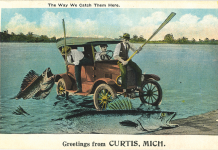
Motorbuses played an essential role in Michigan’s tourist industry. Bus service appeared on the Michigan scene in the early 1920s, in many cases, replacing interurban rail service by the end of the decade. The first routes were relatively short, from one city or town to another. State regulation of buses went into effect in 1923 as the number of bus companies increased. The demand for extended service grew, and by 1940, there were over 30 intrastate bus companies operating in Michigan.
Some were large, like the Greyhound Lines that serviced a wide area; others were smaller, like the Petoskey-Harbor Springs Bus Line, that only operated between those two towns. Eventually, increased regulation and higher standards imposed by the state drove out some of the smaller lines, while other lines merged with larger companies.
Many families did not own automobiles in the first half of the 20th century, and travel to vacation spots by bus was relatively common. The Greyhound Lines is perhaps the most well-known, but there also was the Shore Line Motor Coach Company, Blue Goose Lines, Short Ways Lines, Great Lakes Motor Bus Company, Eastern Michigan Motorbuses, Indian Trails, North Star Lines and others that serviced many of Michigan’s vacation spots.
Greyhound, promoting the attractions of Michigan in 1937, stated that “Michigan is one vast playground, equipped with ideal natural facilities for any kind of vacation.”
Michigan’s tourist industry enticed vacationers with its splendid resorts, beautiful beaches, crystal fishing lakes and streams, water sports, first-rate golf courses, sand dunes and other features. Greyhound, promoting the attractions of Michigan in 1937, stated that “Michigan is one vast playground, equipped with ideal natural facilities for any kind of vacation.”
Low bus fares were promoted as the economical way to take a vacation trip. Greyhound claimed that one could travel 3 miles on their buses for what it would cost to drive a private automobile 1 mile, adding to the “length of your vacation with the money you save by going by Greyhound.”
Traffic worries were relieved by expert, courteous, uniformed “chauffeurs,” and one could sit back, relax and enjoy the scenery. For the passenger’s comfort, some bus lines advertised “cushioned reclining chairs” and “excellent ventilation.”

Some lines offered liberal stopover privileges and route options. This meant that the traveler could go by one route and return by an entirely different route without adding to the cost of the trip and enjoying more scenery along the way. Stopovers could be arranged at no extra cost, or if desired, passengers could go straight through in “express time.”
Numerous comfort and meal stops were provided. The Blue Goose Lines advertised “when you reach your destination, you are more relaxed for you have experienced no driving worries.”
Some bus companies increased their runs during the summer months to cater to traveling tourists. For example, in 1927, Muskegon-based Safety Motor Coach Lines, known to riders as Greyhound, ran hourly from Chicago to all the major West Michigan resort towns as far north as Ludington and as far east as Grand Rapids.
Some of the bus lines offered all-expense tours for a Michigan vacation. The Blue Goose Lines offered five different tours in the 1930s, including a seven-day Soo tour, a seven-day Blaney Park tour, a Mullett Lake weekend tour and two different tours to Mackinac Island.

The Greyhound Travel Bureau offered sightseeing tours all over America, including Michigan with the northern Great Lakes excursion. Everything was planned for the vacationer in advance, covering hotel accommodations, side trips, special sight-seeing and entertainment.
Starting in the 1920s, sight-seeing tours were offered in Detroit by the Gray Line Motor Tours Company. The “Seeing Detroit” tour covered the downtown area and the automobile district, including the Ford factory. The “Lake Shore Drive – Grosse Pointe” tour took passengers to the “finest part of Detroit” and its suburbs. Similar tours were offered by Chambers Sight-Seeing Tours and the Van Dyke Line.
A 1941 slogan stated, “Michigan’s the place to go! Buses are the way to go!” But today with most families owning an automobile, vacation travel by bus is not the popular attraction it once was. We can look back with a bit of nostalgia for the days of the “car-free … care-free way” of travel by bus.
BLUE Vintage Views Columnists M. Christine Byron and Thomas R. Wilson reside in Grand Rapids. They are authors of the new book “Vintage Views Along Scenic M-22 including Sleeping Bear Dunes.”







Facebook Comments